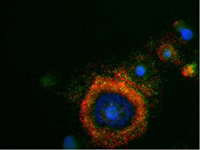|
Compulsive Overeating
A food addiction or eating addiction is any behavioral addiction characterized primarily by the compulsive consumption of palatable and hyperpalatable food items, and potentially also sugar-sweetened beverages (SSBs). Such foods often have high sugar, fat, and salt contents ( HFSS), and markedly activate the reward system in humans and other animals. Those with eating addictions often overconsume such foods despite the adverse consequences (such as excess weight gain, diabetes, and heart disease) associated with their overconsumption. [Baidu] [Amazon] |
Behavioral Addiction
Behavioral addiction, process addiction, or non-substance-related disorder is a form of addiction that involves a compulsive behavior, compulsion to engage in a rewarding non-Chemical substance, substance-related behavior – sometimes called a natural reward – despite any negative consequences to the person's physical, mental, social or financial well-being. In the brain's reward system, a gene transcription factor known as ΔFosB has been identified as a necessary common factor involved in both behavioral and drug addictions, which are associated with the same set of neural adaptations. Addiction canonically refers to substance abuse; however, the term's connotation has been expanded to include behaviors that may lead to a reward (such as gambling, eating, or shopping) since the 1990s. Still, the framework to diagnose and categorize behavioral addiction is a controversial topic in the psychopathology field. Psychiatric and medical classifications ''Diagnostic and Statistical ... [...More Info...] [...Related Items...] OR: [Wikipedia] [Google] [Baidu] [Amazon] |
Biomarker (medicine)
In medicine, a biomarker is a measurable wikt:indicator, indicator of the severity or presence of some disease state. It may be defined as a "cellular, biochemical or molecular alteration in cells, tissues or fluids that can be measured and evaluated to indicate normal biological processes, pathogenic processes, or pharmacological responses to a therapeutic intervention." More generally a biomarker is anything that can be used as an indicator of a particular disease state or some other physiological state of an organism. According to the WHO, the indicator may be chemical, physical, or biological in nature - and the measurement may be functional, physiological, biochemical, cellular, or molecular. A biomarker can be a substance that is introduced into an organism as a means to examine organ function or other aspects of health. For example, rubidium chloride is used in isotopic labeling to evaluate perfusion of heart muscle. It can also be a substance whose detection indicates a ... [...More Info...] [...Related Items...] OR: [Wikipedia] [Google] [Baidu] [Amazon] |
Food Calorie
The calorie is a unit of energy that originated from the caloric theory of heat. The large calorie, food calorie, dietary calorie, kilocalorie, or kilogram calorie is defined as the amount of heat needed to raise the temperature of one liter of water by one degree Celsius (or one kelvin). The small calorie or gram calorie is defined as the amount of heat needed to cause the same increase in one milliliter of water. Thus, 1 large calorie is equal to 1,000 small calories. In nutrition and food science, the term ''calorie'' and the symbol ''cal'' may refer to the large unit or to the small unit in different regions of the world. It is generally used in publications and package labels to express the energy value of foods in per serving or per weight, recommended dietary caloric intake, metabolic rates, etc. Some authors recommend the spelling ''Calorie'' and the symbol ''Cal'' (both with a capital C) if the large calorie is meant, to avoid confusion; however, this convention ... [...More Info...] [...Related Items...] OR: [Wikipedia] [Google] [Baidu] [Amazon] |
